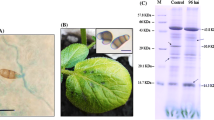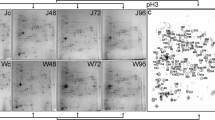Abstract
Citrus proteome changes at 8 and 48 h post inoculation (hpi) were analysed by both 2D gel electrophoresis and nano-LC-MS/MS proteomic approaches during interaction with Xanthomonas axonopodis pv. citri (Xac) and Xanthomonas oryzae pv. oryzae (Xoo) as host and non-host pathogens, respectively. A total of 256 proteins, 72 at 8 hpi and 184 at 48 hpi, differentially accumulated during citrus-Xanthomonas interaction. Of these, 67 and 115 proteins were specific to Xac and Xoo interaction, respectively. In addition, 64 proteins, 10 at 8 hpi and 54 at 48 hpi, variedly accumulated during both the interactions. Proteins related to photosynthesis, carbohydrate metabolism and protein synthesis were in low abundance during both the interactions resulting in reduced rate of photosynthesis. Proteins related to defence response, cell wall (CW) strengthening, lignin deposition and generation of reactive oxygen species (ROS) were in high abundance only during Xoo interaction. Whereas, during Xac interaction, proteins involved in antioxidant metabolism and CW loosening and/or elongation were in high abundance. The precise increase in abundance of these proteins during non-host interaction suggested an important role for CW fortification and ROS accumulation in non-host resistance in plants.







Similar content being viewed by others
Abbreviations
- NHR:
-
Non-host resistance
- LC-MS/MS:
-
Liquid chromatography-tandem mass spectrometry
- 2DE:
-
2D electrophoresis
- Xac :
-
Xanthomonas axonopodis pv. citri
- Xac :
-
Xanthomonas oryzae pv. oryzae
- ROS:
-
Reactive oxygen species
- PRX:
-
Peroxidase
- SOD:
-
Superoxide dismutase
- APX:
-
Ascorbate peroxidase
- XTH:
-
Xyloglucan endotransglycosylase/hydrolase
- CW:
-
Cell wall
References
An C, Mou Z (2012) Non-host defense response in a novel Arabidopsis-Xanthomonas citri subsp. citri Pathosystem. PLoS One 7:e31130
Asirvatham VS, Watson BS, Sumner LW (2002) Analytical and biological variances associated with proteomic studies of Medicago truncatula by two-dimensional polyacrylamide gel electrophoresis. Proteomics 2:960–968
Austin MJ, Muskett P, Kahn K et al (2002) Regulatory role of SGT1 in early R gene-mediated plant defenses. Science 295:2077–2080
Beauchamp C, Fridovich I (1971) Superoxide dismutase: improved assays and an assay applicable to acrylamide gels. Anal Biochem 44:276–287
Bevan M, Bancroft I, Bent E et al (1998) Analysis of 1.9 Mb of contiguous sequence from chromosome 4 of Arabidopsis thaliana. Nature 391:485–488
Bonfig KB, Schreiber U, Gabler A et al (2006) Infection with virulent and avirulent P. syringae strains differentially affects photosynthesis and sink metabolism in Arabidopsis leaves. Planta 225:1–12
Caraux G, Pinloche S (2005) PermutMatrix: a graphical environment to arrange gene expression profiles in optimal linear order. Bioinformatics 21:1280–1281
Daurelio LD, Petrocelli S, Blanco F et al (2011) Transcriptome analysis reveals novel genes involved in nonhost response to bacterial infection in tobacco. J Plant Physiol 168:382–391
Daurelio LD, Romero MS, Petrocelli S et al (2013) Characterization of Citrus sinensis transcription factors closely associated with the non-host response to Xanthomonas campestris pv. vesicatoria. J Plant Physiol 170:934–942
Garavaglia BS, Thomas L, Zimaro T et al (2010) A plant natriuretic peptide-like molecule of the pathogen Xanthomonas axonopodis pv. citri causes rapid changes in the proteome of its citrus host. BMC Plant Biol 10:e8950
Heath RL, Packer L (1968) Photoperoxidation in isolated chloroplast. I. Kinetics and stoichiometry of fatty acid peroxidation. Arch Biochem Biophys 125:189–198
Henkel AW, Bieger SC (1994) Quantification of proteins dissolved in an electrophoresis sample buffer. Anal Biochem 223:329–331
Huckelhoven R (2007) Cell wall-associated mechanisms of disease resistance and susceptibility. Annu Rev Phytopathol 45:101–127
Isaacson T, Damasceno CM, Saravanan RS et al (2006) Sample extraction techniques for enhanced proteomic analysis of plant tissues. Nat Protoc 1:769–774
Kang L, Li J, Zhao T et al (2003) Interplay of the Arabidopsis nonhost resistance gene NHO1 with bacterial virulence. Proc Natl Acad Sci U S A 100:3519–3524
Kanzaki H, Saitoh H, Ito A et al (2003) Cytosolic HSP90 and HSP70 are essential components of INF1-mediated hypersensitive response and non-host resistance to Pseudomonas cichorii in Nicotiana benthamiana. Mol Plant Pathol 4:383–391
Kundu S, Chakraborty D, Pal A (2011) Proteomic analysis of salicylic acid induced resistance to Mungbean Yellow Mosaic India Virus in Vigna mungo. J Proteomics 74:337–349
Li B, Takahashi D, Kawamura Y et al (2012a) Comparison of plasma membrane proteomic changes of Arabidopsis suspension-cultured cells (T87 Line) after cold and ABA treatment in association with freezing tolerance development. Plant Cell Physiol 53:543–554
Li W, Xu Y-P, Zhang Z-X et al (2012b) Identification of genes required for nonhost resistance to Xanthomonas oryzae pv. oryzae reveals novel signaling components. PLoS One 7:e42796
Liu H, Wang Y, Xu J et al (2008) Ethylene signaling is required for the acceleration of cell death induced by the activation of AtMEK5 in Arabidopsis. Cell Res 18:422–432
Liu Y, Schiff M, Serino G et al (2002) Role of SCF ubiquitin-ligase and the COP9 signalosome in the N genemediated resistance response to tobacco mosaic virus. Plant Cell 14:1483–1496
Ma QU (2007) Small GTP-binding proteins and their functions in plants. J Plant Growth Regulation 26:369–388
Matsumura H, Reich S, Ito A et al (2003) Gene expression analysis of plant host-pathogen interactions by SuperSAGE. Proc Natl Acad Sci U S A 100:15718–15723
Meunier B, Dumas E, Piec I et al (2007) Assessment of hierarchical clustering methodologies for proteomic data mining. J Proteome Res 6:358–366
Nakano A, Asada K (1987) Purification of ascorbate peroxidase in spinach chloroplasts: its inactivation in ascorbate-depleted medium and reactivation by monodehydroascorbate radical. Plant Cell Physiol 28:131–140
Nouri M-Z, Komatsu S (2010) Comparative analysis of soybean plasma membrane proteins under osmotic stress using gel-based and LC MS/MS-based proteomics approaches. Proteomics 10:1930–1945
Nurnberger T, Lipka V (2005) Non-host resistance in plants: new insights into an old phenomenon. Mol Plant Pathol 6:335–345
Nurnberger T, Scheel D (2001) Signal transmission in the plant immune response. Trends Plant Sci 6:372–379
Oh S-K, Lee S, Chung E et al (2006) Insight into types I and II nonhost resistance using expression patterns of defense-related genes in tobacco. Planta 223:1101–1107
Overmyer K, Brosche M, Kangasjarvi J (2003) Reactive oxygen species and hormonal control of cell death. Trends Plant Sci 8:335–342
Rani TS, Podile AR (2014) Extracellular matrix-associated proteome changes during non-host resistance in citrus-Xanthomonas interactions. Physiol Plant 150:565–579
Roberts MR, Salinas J, Collinge DB (2002) 14-3-3 proteins and the response to abiotic and biotic stress. Plant Mol Biol 50:1031–1039
Schulze-Lefert P, Panstruga R (2011) A molecular evolutionary concept connecting nonhost resistance, pathogen host range, and pathogen speciation. Trends Plant Sci 16:117–125
Senthil-Kumar M, Mysore KS (2013) Nonhost resistance against bacterial pathogens: retrospectives and prospects. Annu Rev Phytopathol 51:19.1–19.21
Shevchenko A, Wilm M, Vorm O et al (1996) Mass spectrometric sequencing of proteins silver-stained polyacrylamide gels. Anal Chem 68:850–858
Takahashi D, Kawamura Y, Uemura M (2013) Changes of detergent-resistant plasma membrane proteins in oat and rye during cold acclimation: association with differential freezing tolerance. J Proteome Res doi.org/10.1021/pr400750g
Takahashi D, Kawamura Y, Yamashita T et al (2012) Detergent-resistant plasma membrane proteome in oat and rye: similarities and dissimilarities between two monocotyledonous plants. J Proteome Res 11:1654–1665
Talla S, Riazunnisa K, Padmavathi L et al (2011) Ascorbic acid is a key participant during the interactions between chloroplasts and mitochondria to optimize photosynthesis and protect against photoinhibition. J Biosci 36:163–173
Tao Y, Xie Z, Chen W et al (2003) Quantitative nature of Arabidopsis responses during compatible and incompatible interactions with the bacterial pathogen Pseudomonas syringae. Plant Cell 15:317–330
Thordal-Christensen H, Zhang Z, Wei Y et al (1997) Subcellular localization of H2O2 in plants. H2O2 accumulation in papillae and hypersensitive response during the barley-powdery mildew interaction. Plant J 11:1187–1194
Uma B, Rani TS, Podile AR (2011) Warriors at the gate that never sleep: non-host resistance in plants. J Plant Physiol 168:2141–2152
Vallet C, Chabbert B, Czaninski Y et al (1996) Histochemistry of lignin deposition during sclerenchyma differentiation in alfalfa stems. Annu Bot 78:625–632
Velikova V, Yordanov I, Edreva A (2000) Oxidative stress and some antioxidant systems in acid rain-treated bean plants: protective roles of exogenous polyamines. Plant Sci 151:59–66
Wang X, Li X, Li Y (2007) A modified commassie brilliant blue staining method at nanogram sensitivity compatible with proteomic analysis. Biotechnol Lett 29:1599–1603
Zamany A, Liu J-J, Ekramoddoullah AKM (2012) Comparative proteomic profiles of Pinus monticola needles during early compatible and incompatible interactions with Cronartium ribicola. Planta 236:1725–1746
Zimaro T, Gottig N, Garavaglia BS et al (2011) Unraveling plant responses to bacterial pathogens through proteomics. J Biomed Biotechnol 2011:354801
Acknowledgments
We thank UGC-CAS programme and Proteomics Facility (DBT-CREBB) of School of Life Sciences and DST-FIST facility of Plant Sciences Department at University of Hyderabad. TSR acknowledges the research fellowship from DBT-CREBB and DST-INSPIRE, India. The research performed in Iwate University was in part supported by Grants-in-Aid (#22120003 and #24370018to MU and #24-7373 to DT) from Japan Society for the Promotion of Science (JSPS).
Conflict of interests
The authors declare that they have no competing interests.
Author’s contributions
TSR carried 2DE, biochemical analysis and statistical analysis. TSR and DT performed nano-LC-MS/MS. ARP designed the experiments, and TSR, DT, MU and ARP wrote the final draft of the manuscript. All authors read and approved the manuscript.
Author information
Authors and Affiliations
Corresponding author
Electronic supplementary material
Below is the link to the electronic supplementary material.
Supplementary Fig. S1
Representation of functional categories of differentially regulated proteins: Proteins responded to pathogen challenge (Xac or Xoo) were assigned to functional categories based on biological process, shown as percent of total response in each category at 8 hpi (right panel) and at 48 hpi (left panel) are shown (GIF 140 kb)
Supplementary Fig. S2
Venn diagram analysis of the expression patterns of differentially expressed proteins during regulated proteins: Proteins differentially expressed during Xac and Xoo interaction a) at 8 hpi, b) at 48 hpi, and c) overlapping proteins at 8 and 48 hpi are shown (GIF 83 kb)
Supplementary Fig. S3
Measurement of photosynthetic rate: Pattern of photosynthetic oxygen evolution in citrus during mock, Xac and Xoo challenge at 8 and 48 hpi were measured. Error bars indicate standard deviation of the mean from three independent experiments. hpi-hours post inoculation (GIF 97 kb)
Supplementary Tables S1-S5
(XLSX 903 kb)
ESM 1
(PPTX 289 kb)
Rights and permissions
About this article
Cite this article
Rani, T.S., Takahashi, D., Uemura, M. et al. Proteins Associated with Oxidative Burst and Cell Wall Strengthening Accumulate During Citrus-Xanthomonas Non-Host Interaction. Plant Mol Biol Rep 33, 1349–1360 (2015). https://doi.org/10.1007/s11105-014-0817-y
Published:
Issue Date:
DOI: https://doi.org/10.1007/s11105-014-0817-y




